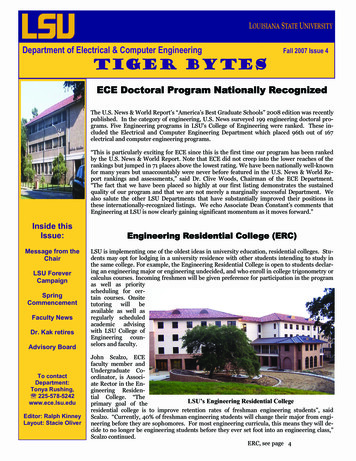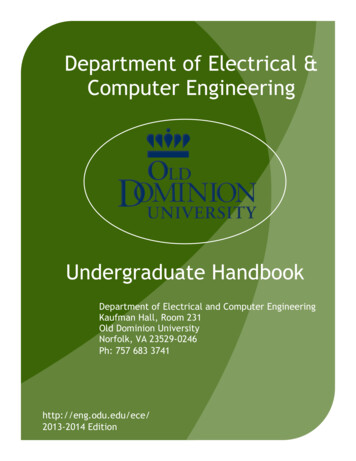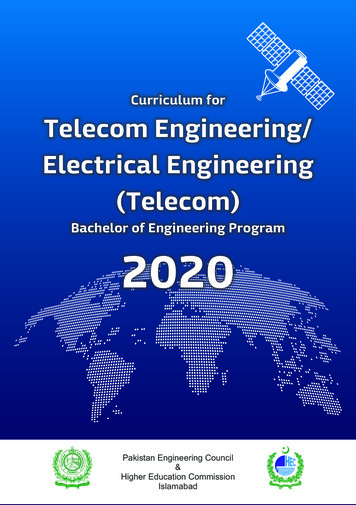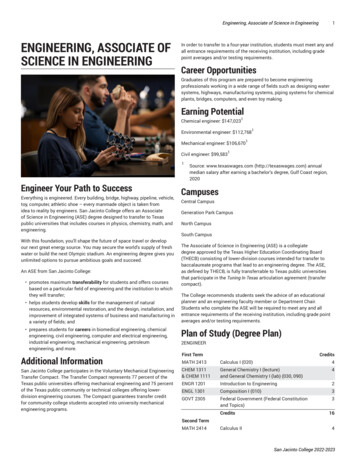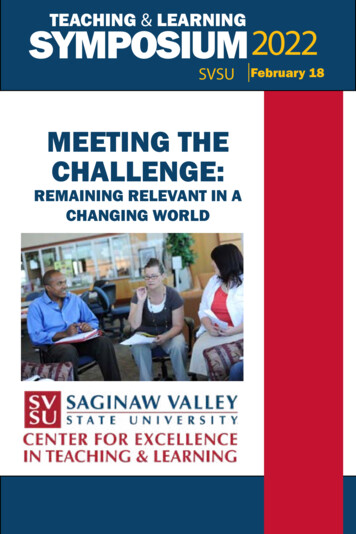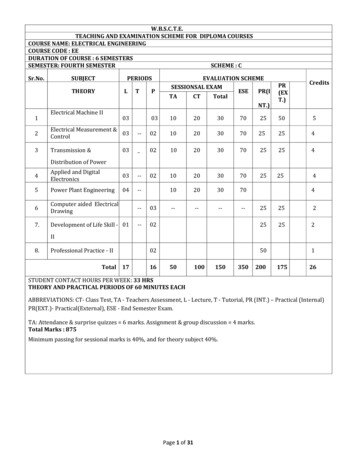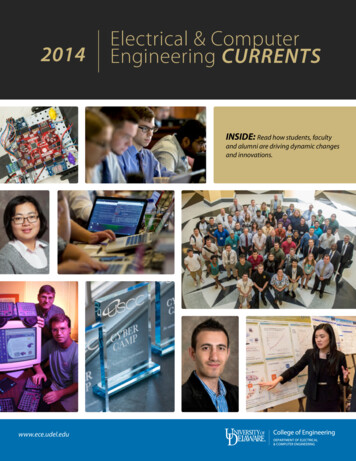
Transcription
2014Electrical & ComputerEngineering CURRENTSINSIDE: Read how students, facultyand alumni are driving dynamic changesand innovations.www.ece.udel.edu
INTRODUCTIONSECTIONELECTRICAL & COMPUTER ENGINEERING 2014I am pleased to share the latest Currents,highlighting news and achievements fromUD’s Department of Electrical and ComputerEngineering (ECE). Inside you will see howour students, faculty and alumni are drivingdynamic changes and innovations in our field.UD ECE has improved 24 places in the U.S.News & World Report departmental rankingsover the past five years, and is now ranked55. Undergraduate enrollment increasedmore than 60 percent over that sametimeframe—90 freshman ECE students werewelcomed to campus this September—andgraduate enrollment increased by 33 percent.MESSAGEFROM THECHAIRKENNETH E.BARNERBe sure to like theUniversity of Delaware Electricaland Computer EngineeringDepartment Facebook page!2The gains in recognition and enrollment area reflection of UD ECE dynamism manifestedin program innovations, faculty researchand student achievements. Cybersecurityis just one area of broad innovation. Acybersecurity minor is now a popular optionfor students, and three new faculty membersjoined ECE to advance the cybersecurityresearch and curriculum efforts: PROF.STARNES WALKER is the founding directorof UD’s Cyber Security Initiative (CSI); PROF.HAINING WANG, formally at William & Mary,brings a well-established group focused onattacks and countermeasures inside datacenters to UD; and PROF. CHASE COTTONbrings 30 years of industry security expertiseto UD as the department’s first Professor ofPractice. The cybersecurity research portfoliocontinues to grow and a new cybersecurity MSprogram is anticipated to accept its first cohortin September 2015.ECE Research Day celebrated scholarship,innovation and accomplishments by students,faculty and alumni. Highlights includedstudent capstone project and research posters,and a Distinguished Lecture by DAVIDWELCH (EE ’81), co-founder and presidentof Infinera Corp. Dr. Welch was also honoredwith the ECE Distinguish Achievement Award.Fellow alumni MARK MELILLO (EE ’82),Entrepreneurial Innovation Award, KRISTOFERROE (EE ’95, M ’97, PH.D. ’01), OutstandingService Award, and JAMES ORR (B ’01, M’04), Young Alumni Achievement Award, werealso recognized for their accomplishments.Mark your calendar now for the 2015 ResearchDay on March 11, which features a DistinguishLecture by JAN ALLEBACH (EE ’72), HewlettPackard Distinguished Professor of ECE, PurdueUniversity.Students continue to excel individually andcollectively. KEVIN LANE, SAGAR PATEL,THOMAS PIACENTINO, DYLAN ROSSand NAVDEEP SEKHON received theOutstanding Capstone Senior Design ProjectAward for their project “Dead ReckoningTracking System for Application in GPSDegraded Environments.” And the UD EpsilonOmicron student chapter of the IEEE-EtaKappa Nu was honored with the OutstandingChapter Award—one of 23 studentorganizations recognized for excellence inchapter activities.I am extremely proud of the accomplishmentsshowcased in the following pages, and amconfident that as UD ECE continues on itsstrategic path as a field leader, even greaterachievements will be realized. I thank ourmany alumni, friends and industry partnerswho provide the support that is integral toour efforts for excellence in education andresearch.In this issue.4612141819ResearchNews & EventsAlumniStudentsFacultyAdvisory Council Content Direction: Kenneth Barner Design, Photography & Writing:Office of Communications & Marketing Printing: University PrintingUNIVERSITY OF DELAWAREElectrical & Computer Engineering2014-15 DISTINGUISHED LECTURE SERIESSEPTEMBER 24, 2014AYDOGAN OZCANUNIV. OF CALIFORNIALOS ANGELES“Democratization of NextGeneration Imaging, Diagnosticsand Measurement Tools ThroughComputational Photonics”NOVEMBER 12, 2014REINALDOVALENZUELAALCATEL-LUCENT BELLLABORATORIES“5G: Technology Opportunitiesand Challenges”As always, feel free to contact me at barner@udel.edu with your ideas and feedback.MARCH 11, 2015JAN ALLEBACHPURDUE UNIVERSITYKenneth E. Barner, PhDProfessor and ChairElectrical and Computer Engineering140 Evans Hall, Newark, DE 19716-3130 302-831-2405 info@ece.udel.edu“Digital Printing: TheTransformation of a 2,000Year Old Technology andWhat It Means to You”Visit www.ece.udel.edu for webcasting and details.APRIL 22, 2015NAOMI HALASRICE UNIVERSITY“Plasmonics: a Nanoscale Focuson Cross-cutting Science andTechnologies”Co-Sponsored by theDelaware Bay IEEE3
RESEARCHELECTRICAL & COMPUTER ENGINEERING 2014Understanding HIV: NatureMedicine paper explores role ofBIG DATAANALYSIS:T-cells in HIVResearchersmine data toRYAN ZURAKOWSKI’S co-authored paper “HIV-1 Persistence inCD4 T-Cells with Stem Cell-Like Properties,” published January 12 inNature Medicine, provides evidence that a particular T-cell type may helpresearchers better understand why HIV can persist despite treatment.analyze politicalAccording to Zurakowski, associate professor, HIV treatments do not killinfected cells. Instead, they stop the infection of new cells, and rely onthe virus itself to kill the infected cells. Unfortunately, some cells infectedby the virus—memory T-cells—are not killed by the virus.mobile devicesT-cells are a type of lymphocyte, or white blood cell, produced by thethymus gland that actively participates in the body’s immune response.“Memory” T-cells can live for years, or even decades, providing life-longimmunity to previously encountered diseases. They can form “quiescent”infections, which last for years, and cause HIV to rebound whenever apatient stops treatment.During the 10-year study, the researchers discovered that not allmemory T-cells are alike. A sub-group, Stem Memory T-Cells (Tscm), aredifferent, particularly in their ability to produce daughter cells.The researchers were able to show that the HIV-infected Tscm cells inpatients on HIV therapy decayed more slowly than any other type ofT-cell. As a result, after 10 years of therapy, the Tscm cells represented 24percent of the total HIV-infected cell population, despite being only 1percent of the total T-cell population.This finding is significant, Zurakowski said, because it demonstrates thatTscm cells are the slowest-decaying portion of the HIV reservoir.“Over time, this particular cell type plays an increasingly significant rolein sustaining HIV infection in patients who have remained on therapy,”he said.Zurakowski’s co-authors include lead author Mathias Lichterfeldfrom Harvard University Center for AIDS Research, and researchersfrom Massachusetts General Hospital; Ragon Institute of MGH, theMassachusetts Institute of Technology and Harvard University; the FirstAffiliated Hospital of China Medical University; Brigham and Women’sHospital; and Howard Hughes Medical Institute.Zurakowski credits the finding to the diligence of Lichterfeld and theresearchers at the Ragon Institute in carefully following the same HIVpatients for a decade.4behavior onRyan Zurakowski“If we can find a way to selectivelyeliminate the HIV-infected Tscm cells, itwill be a major step in developing a true‘cure’ for HIV infection.” —Ryan ZurakowskiHui FangAs tablets and other mobile devices become an increasingly commonpart of everyday life, researchers in political communication arefocusing more of their attention on how people use that technology toaccess news and other information.A study published in the Journal of Information Technology andPolitics by assistant professor HUI FANG and LINDSAY HOFFMAN,associate professor of communication, revealed that users: Spent more time with online aggregators (such as Google),recreational sites (playing games, for example) and social networkingsites than with news or political sites;“Because the researchers have followed the same patients over adecade, we have created a high-fidelity data set that would nototherwise have been possible,” he said.Drugs currently being developed for cancer therapy that target stemcell metabolic pathways may be able to target this cell type, as well, dueto the “stem-cell like” nature of the Tscm cells, he said.A better understanding of how the HIV virus leverages a cell’s stem celllike properties of cellular immune memory to stay alive could lead toimproved clinical strategies for HIV treatment.The research reported in this paper was funded, in part, by the AmericanFoundation for AIDS Research, the U.S. National Institutes of Health,the Mark and Lisa Schwartz Foundation and the Bill and Melinda GatesFoundation.Article by Karen B. Roberts Photo by Ambre Alexander Payne Tended to overestimate the time they spent with online news, butwhen they were on news sites, they spent an average of 10 minutes oneach page, with national and regional news the most popular; and Showed what Hoffman called “selective exposure,” meaning thatthey were much more likely to visit sites that shared their liberal orconservative point of view rather than seeking out opposingideologies.“The data analysis in this project is a perfect example of ‘big data’analysis,” said Fang. “The main goal is to understand user behaviorsbased on the traces they left when surfing on the Internet,” a challengethat she called “not a trivial task.”The limitation of previous similar studies, said Hoffmnan, is that theyrelied on the users’ reports about their own behavior. “Scholars havesurveyed people about how and why they use media, but that use isvery fluid. It’s so interspersed with other daily activities that mostLindsay Hoffman“The main goal is to understand userbehaviors based on the traces they leftwhen surfing on the Internet.” —Hui Fangpeople would find it difficult to say exactly how many minutes theyspend on particular kinds of website,” said Hoffman.Hoffman and Fang’s study tracked the websites visited and timespent on each by 20 carefully selected participants over four monthsduring the 2012 presidential campaign season. Each website was thencategorized by type and political leaning, from conservative to liberal,and the results were coded for computer analysis by nine students overthe past three years.Because only 20 people were tracked, Hoffman notes the study haslimited use in generalizing about user behavior. Instead, she said, thesignificance is in demonstrating that this type of tracking method canbe used for further research.“To say that the Internet has radically changed the way people gettheir news in the new digital era is an understatement,” she said. “Astechnology use changes, so must our methodologies to advanceresearch and theory in information technology and politics.”Article by Ann Manser5
NEWS/EVENTSELECTRICAL & COMPUTER ENGINEERING 2014Cybersecurity“Starnes Walker understands whatit takes to defend a nation againstcyber threats. Cyber attackersare growing increasingly moresophisticated, now becomingmore interested in taking outentire systems instead of justcompromising data.Starnes WalkerNational defense expert leads UDcybersecurity initiativeLeading national cybersecurity expert STARNES WALKER has joined UD asfounding director of the new University of Delaware Cybersecurity Initiative(UDCSI).“With Dr. Walker’s appointment, the University of Delaware gainsexceptional expertise in an area of urgent concern,” said University ProvostDomenico Grasso. “Under his leadership, UD will develop new partnershipsto advance cybersecurity education and research and will create prominentacademic programs at the undergraduate and graduate levels, as well ascertificate programs for corporate and government professionals.”Walker has held senior management positions in the U.S. Departments ofDefense, Energy and Homeland Security, as well as in industry.Defending the United States from cyber attacks requires highly trainedspecialists who can design secure computing systems, write securecomputer code and create tools to protect, detect and recover frommalicious acts, Walker said. The need is immediate, and the stakes are high.“Academia will play an importantrole in developing solutions forshoring up the nation’s cyberdefense.”—M ichael Hayden, retired U.S. Air Force four-star generaland former director of the National Security Agency andof the Central Intelligence AgencyAcademia will play animportant role in developingsolutions for shoring up thenation’s cyber-defense.”Elite cyber talent: training camp drawsstudents from around the stateAs cyber attacks increase in frequency and scope, identifying andtraining people to thwart these attacks is an increasingly urgentneed.Professor CHASE COTTON, PH.D. 1985, said that the campprepares participants for careers by exposing them to both theoffensive and defensive aspects of the work.“One person with a laptop can have just as much effect as an entirearmy,” said JAMES LUCK, now a senior Honors Program studentstudying computer science.“The defensive nature of this field requires students to understandthe defects in a system and how to bypass them so that they cancreate preventive measures to protect information, or know how ahacker may have already entered the system,” he said.Luck was one of 62 students from UD, Wilmington University,Delaware Technical Community College, Delaware State Universityand several local high schools, who along with local securityprofessionals, participated in the United States Cyber Challenge(USCC) camp hosted this summer at UD.USCC is a national program that works with states to connect cybertalent to the industry. Camp participants attended in-depth classeson digital forensics, web penetration testing and packet craftingtaught by cybersecurity experts, in addition to a career fair thatcould potentially help them land jobs.A capture the flag attack and defense competition rounded out theweek, with campers testing their new skills by completing tasks toeither hack, or protect, a server.This year’s event was supported, in part, through sponsorshipsby the State of Delaware, SANS Institute, CyberAces, Associationfor Federal Information Resources Management, Department ofHomeland Security, Microsoft and Lockheed Martin. Local sponsorsinclude Wilmington University, Delaware State University, UD andPJM.ECE Department Chair KENNETH BARNER was joined at theawards ceremony in commending camp participants by U.S. Sen.Tom Carper (Del), chair of the Senate Committee on HomelandSecurity and Governmental Affairs, Delaware Gov. Jack Markell,Delaware Chief Security Officer Elayne Starkey and DelawareSecretary of Education Mark Murphy.Article by Collette O’Neal Photos by Evan Krape— Michael Hayden, retired U.S. Air Force four-stargeneral and former director of the National SecurityAgency and of the Central Intelligence AgencyWalker’s top goals for the initiative include developing problem-based andexperiential learning programs—areas in which UD has been a pioneer—and developing cybersecurity activities in partnership with colleges anddepartments across campus and with corporations and government entities.Adapted from an article by Tracey Bryant67
ELECTRICAL & COMPUTER ENGINEERING 2014SECTIONNew cybersecurityminor offeredThis fall, the electrical andcomputer engineering departmentbegan offering a new 18-creditcybersecurity minor allowingstudents to infuse computer andnetwork security fundamentalsinto their current degree program.A master’s degree programin cybersecurity is also underdevelopment.89
NEWS/EVENTSELECTRICAL & COMPUTER ENGINEERING 2014Science Coalition reporthighlights ECE spin-offAlumnus David Welchdelivers keynote at 2014ECE Research DayA University of Delaware spin-off company,which grew out of federally funded research byECE Endowed Distinguished Professor GUANGGAO, is highlighted in a new national report byThe Science Coalition.DAVID WELCH, EE1981, co-founder and presidentThe report, “Sparking Economic Growth 2.0:Companies Created from Federally FundedResearch, Fueling American Innovation andEconomic Growth,” identifies 100 companiesthat trace their roots to federally fundeduniversity research. These companies — whileonly a tiny fraction of the new companiesformed each year — are contributing to the U.S.economy in a significant way.Gao’s E.T. International Inc. (ETI), located inNewark, Del., provides advanced computingsystems and software based on new multi-corechip technology to analyze “big data” — large,complex data sets that are critical to a wide arrayof global businesses.“From Dick Heck’s Nobel Prize-winning chemistryresearch that today finds use in pharmaceuticals,to electronics, to the touch screen technologyof John Elias and Wayne Westerman that laid thefoundation for smart phones and tablets, UD’sfederally funded research has been impactingthe world,” said Charlie Riordan, vice provost forresearch.“It’s gratifying to see Professor Guang Gaotake his computing solutions seeded by thedepartments of Defense and Energy to marketby founding ET International, a company herein Delaware that employs more than 20 peopleand provides software solutions to some of theworld’s biggest companies,” Riordan added.The basic scientific research that gives rise tocompanies like ETI, and spurs the economyin many other ways, is jeopardized by thecurrent funding environment. Federal fundingfor research and development has been on10of global optical telecommunications companyInfinera Corp, delivered the keynote addressat the Department of Electrical and ComputerEngineering Research Day last March, and was alsohonored with a distinguished achievement award.Guang Gaoa downward trend for the past decade, withfunding levels in 2013 at historic lows.“The federal funding I received in the late 1990sand early 2000s was instrumental in my researchgroup’s fundamental and long-term researchon a dataflow model of computation — thevery research on which ETI was founded,” Gaosaid. “Dataflow modeling is critically importantto big data technology, and today provides ETItechnology a competitive edge.”As the report points out, university research andthe companies born from such research are adriving force behind much of the innovationin the United States. They are bringing forwardinnovations with the potential to transformindustries and solve some of the world’s greatestproblems.The Science Coalition is a nonprofit, nonpartisanorganization of more than 50 of the nation’sleading public and private research universities,including the University of Delaware. Itis dedicated to sustaining the federalgovernment’s investment in basic scientificresearch as a means to stimulate the economy,spur innovation and drive America’s globalcompetitiveness.Adapted from an article by Karen B. RobertsPhoto by Ambre AlexanderWelch’s talk titled “Disruptive Innovation inthe Telecommunications Market,” covered theevolution of the telecommunications market,including how optics have displaced traditionaltelecommunications technologies. The lecture,which was part of ECE’s 2013-14 DistinguishedLecture Series, detailed the story of photonicintegration and Infinera.ECE RESEARCH DAYannually recognizes alumniachievements, undergraduateand graduate researchexcellence and outstandingSenior Capstone Projects.Special thanks to eventsponsors DuPont, DTS, ETI,FiBest, IEEE, JPMorgan Chaseand Mentor Graphics.Widely regarded in the optical communicationsfield, Welch is a fellow of the Optical Society andthe Institute of Electrical and Electronics Engineers(IEEE). He is a recipient of the Adolph Lomb Medal,the Joseph Fraunhofer Award and the John TyndallAward. He holds more than 130 patents.Other outstanding department alumni honoredalong with Welch during 2014 Research Dayfestivities were: MARK MELILLO, B1982 – EntrepreneurialInnovation Award; CEO, Melillo Consulting KRISTOFER J. ROE, B1995, M1997, PH.D.2001– Outstanding Service Award; director of R&DImaging, Smiths Detection JAMES E. ORR IV, B2001, M2004 – Young AlumniAchievement Award; AppleM ark your calendar now for the next ECEResearch Day, scheduled for March 11, 2015.David WelchOutstanding studentsCapstone Senior Design Project winnersThe following doctoral students were recognizedduring ECE Research Day for outstandingresearch:Team INERTIA: KEVIN LANE, SAGAR PATEL, THOMASPIACENTINO, DYLAN ROSS, NAVDEEP SEKHON –Dead Reckoning Tracking System for Application in GPSDegraded EnvironmentsBROCK OVERMILLER – Ultrabroadbandphased-array radio frequency (RF) receiversbased on optical techniquesJAIME ARTEAGA – Locality-driven schedulingof tasks for data-dependent multithreadingYIN ZHOU – Stacked predictive sparse codingfor tissue classificationThe following students were also recognized:DYLAN ROSS – Undergraduate Research Award:TiO2 slot like electro-optic polymer phasemodulatorHODA AGHAEIKHOUZANI – IEEE Women inEngineering award11
ALUMNISECTIONELECTRICAL & COMPUTER ENGINEERING 2014Tech pioneers: Inventors of touch imaginginterface technology inducted as NAI FellowsECE alumnus WAYNE WESTERMAN, PHDEE99, and JOHN ELIAS, adjunct professor,have been named fellows of the NationalAcademy of Inventors (NAI).Election to NAI fellow status is a professionaldistinction accorded to current and formeracademic inventors. Westerman and Eliaspioneered the algorithms and touch imaginginterface architecture used in many touchscreen devices.The touch imaging interface they createdchanged the way people interact withcomputers by incorporating scrolling, fingertracking and gesture recognition, featuresfound in electronic devices worldwide,including the iPod, iPhone and iPad.“Wayne and John’s success story is a shiningexample of the entrepreneurial ecosystemthat is being nurtured at UD,” said Brad Yops,director of UD’s Technology Transfer Center,who nominated Westerman and Elias for theaward.It illustrates what can happen when aninnovation in academic research is matchedwith a market need and translated into realworld products.Westerman recently shared the originalmotivation behind the touch imaginginvention and the importance of instilling anentrepreneurial mindset in today’s students.Q: What was the original motivation behindyour touch imaging invention?WESTERMAN: I joined Dr. Elias’ lab in 1995to study neural computation by building andexperimenting with silicon dendrites – oneof the main computational elements in thebrain. I had tendonitis and this motivatedme to tinker with different types of inputtechnology. I noticed my hands had muchmore endurance with zero-force input likeoptical buttons and capacitive touch pads12than force-actuating keys and buttons (thatwere stiffer twenty years ago than today).Q: Was there a Eureka moment in yourresearch?WESTERMAN: Trying to pick a dissertationtopic, I considered training our neuromorphicsilicon circuits to recognize handwritingpatterns – hundreds of researchers had alreadytackled handwriting with simpler methods.The Eureka moment was when I imaginedtraining the neural simulator with multi-fingerpatterns from a zero-force tablet. We beganlooking for one but there were no such tabletson the market. The touch pad manufacturersof the day told Dr. Elias that their productscould not process multi-finger input. SinceI played piano, using all 10 fingers seemedfun and natural and inspired me to createinteractions that flowed more like playing amusical instrument.Q: What contributed to your success?WESTERMAN: Dr. Elias’ expertise buildingcustom circuits and computers wasuncommon amongst professors, but luckilywas just the expertise needed to prototype(and eventually manufacture) advanced inputdevices. Our early experiments with surfacetyping for desktop computers were met withskepticism, but the algorithms we inventedhelped surface typing feel crisp, airy andreasonably accurate despite the lack of tactilefeedback. Hundreds of millions of people nowutilize surface typing on mobile devices.Q: What elements of an entrepreneurialmindset are key for today’s engineers?WESTERMAN: Whether you’re an engineerwith an independent streak who wants tofound your own startup, or you’re morecomfortable within a stable corporation,shipping any new idea requires enormousdetermination, creativity and coordination.Serial entrepreneurs bring a relentless,unstoppable attitude to problem solving;they share a mindset that embraces eachobstacle—be it excessive product complexity,manufacturing cost, organizational ormarketing weakness—as solvable throughcreative exploration, even if that explorationultimately sets them upon a totallyunexpected path.Q: What lessons have you learned that mighthelp future innovators?WESTERMAN: Entrepreneurs must bepractical enough to recognize the flaws intheir product vision and iterate, often for years,until enough flaws are resolved for marketsuccess. To introduce something truly new,it also helps to have a contrarian streak thatleads away from the crowd towards fertileareas that others haven’t yet pursued. If yourideas are truly new (or also if they’re “batty”),the crowd will be skeptical initially. You mustdecide whether you’re on the right path and, ifso, keep pushing.Q: What influence has University of Delawarehad on your career success?WESTERMAN: The diverse courses andenvironment at UD go a long way to preparestudents for joining a startup or corporationwhere working in cross-disciplinary teamsis standard. I garnered lots of insights intoinput device ergonomics by sitting in on abiomechanics class in UD’s physical therapydepartment, taking product design inspirationfrom facts that were intended as therapytraining for the other students. Working withinUD electrical and computer engineering’sfriendly department atmosphere gave methe support and freedom to wander throughseveral zany research topics until I found a newcross-disciplinary niche.Adjunct professor John G. Elias(standing) and ECE alumnus WayneWesterman (seated) show off theirinvention, the fingerworks keyboard/mouse combination.About Westerman and EliasThe touch-sensitive imaging technologygrew out of Wayne Westerman’s UD doctoralthesis. He developed the revolutionarycomputer interface technology with JohnElias, who began developing multitouch userinterfaces for portable and desktop computersystems in 1995.Westerman and Elias co-founded FingerWorksInc. in 1998. It was the first company tocommercialize touch-sensitive imagingtechnology with a line of 10-finger touchpads and keyboards that seamlesslycombined typing, pointing, scrolling andediting gestures within the same surface area.Their early work at UD was supported, in part,by the National Science Foundation. Appleacquired the company in 2005.Article by Karen B. RobertsPhoto Eric CrossanAlumni supportinstrumental in helpingECE grow and excelIn 2005, WAYNE WESTERMAN, PHDEE1999, established a scholarship fundfor undergraduate ECE students whodemonstrated invention, innovation and/orentrepreneurial vision. The 2014 recipientswere JUSTIN PHILLIPS and DANIELLEDUVALSAINT.If you’d like to make a gift to support ECEstudents, faculty and programs, pleasecontact Ken Barner, department chair, at302-831- 2405 or barner@udel.edu; orBarbara Maylath, director of development,College of Engineering, at 302-831-7273 orbmaylath@udel.edu.You may also visit www.udel.edu/makeagiftto use our online giving form and specifyECE in the Other box of “Give to” options.Support from alumni and friends isinstrumental in helping our departmentgrow and excel. Thank you!13
STUDENTSELECTRICAL & COMPUTER ENGINEERING 2014CAPSTONE DESIGN EVENThighlights seniors’ preparation for workforceRoboticsWorldCupStudents, their families, project sponsors, mentors and facultymembers gathered in May for the annual senior capstone celebrationbreakfast and poster session. Department Chair KENNETHE. BARNER offered opening remarks, followed by TERRANCEBOWMAN, 1995, who works for project sponsor JPMorgan Chase,and discussed the students’ contributions toward the industry-baseddesign team assignments. MARK J. MELILLO, B1982, CEO of MelilloConsulting in Somerset, N.J., and the 2014 UD ECE EntrepreneurialInnovation Award recipient, was the featured speaker.StudentsdesignInstructed by Professor CHASE COTTON, PH.D. 1985, SeniorCapstone Design is a six-credit, year-long capstone coursestructured to imitate the scenario a young engineer will experiencein the workforce. Teams select a project, discover customer wants,benchmark the best practices for each desired function, generatedesign concepts, build and test a prototype and make improvements,robots to“walk theline”More than 40 ECE students participated in the second annual RoboticsWorld Cup competition on Friday, May 16.functioning correctly. In real-world engineering, that is what it takes toget the job done.”The event was organized by CHENGMO YANG, assistant professor, as aculminating hands-on opportunity for students to demonstrate designand decision-making skills they learned during their MicroprocessorSystems (CPEG222) class.During the first stage of the competition, teams of two competed sideby-side, racing their robots on identical, parallel tracks. The first robot toconquer the track and stop correctly in the finish zone was deemed thewinner.For the competition, students designed line-following robots using32-bit micro controllers and robot kits. The robots used light sensors todetect tracks as the students controlled the robot’s speed and direction.Teams continued to compete against each other in a round-robinformat, with teams winning two or more races advancing to theelimination stage.TYLER BROWNING, asophomore computerengineering major at thetime of the competition, saidof the design process, “Youhave to be willing to digdeep to solve the problemsat hand. When somethingwas not working correctly,my partner and I were ableto isolate the problem,develop a solution andimplement it into our codein order to get our robot14“The event was filled with suspense and unpredictability,” said Browning.“We had no clue how our robot would react and match up to everyoneelse’s, so it was always exciting to see our robot cross the finish line.”The winners of the competition,
udel.edu with your ideas and feedback. Kenneth E. Barner, PhD Professor and Chair Electrical and Computer Engineering 140 Evans Hall, Newark, DE 19716-3130 302-831-2405 info@ece.udel.edu Be sure to like the University of Delaware Electrical and Computer Engineering Department Facebook page! NOVEMBER 12, 2014 REINALDO VALENZUELA ALCATEL .
